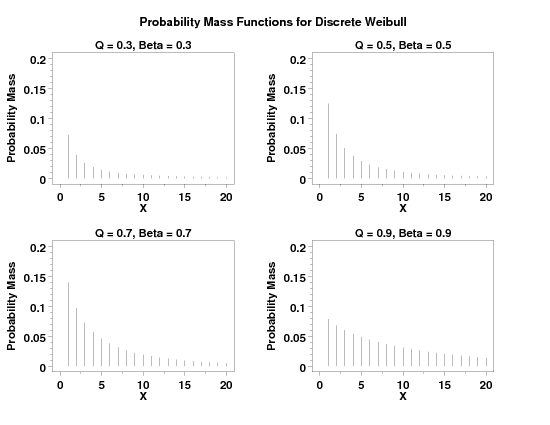

|
DIWPDFName:

with q and
This distribution has application in reliability when the response of interest is a discrete variable.
<SUBSET/EXCEPT/FOR qualification> where <x> is a positive integer variable, number, or parameter; <q> is a number, parameter, or variable in the range (0,1) that specifies the first shape parameter; <beta> is a number, parameter, or variable that specifies the second shape parameter; <y> is a variable or a parameter (depending on what <x> is) where the computed discrete Weibull pdf value is stored; and where the <SUBSET/EXCEPT/FOR qualification> is optional.
LET Y = DIWPDF(X,0.3,0.7) PLOT DIWPDF(X,0.6,0.4) FOR X = 1 1 20
LET Q = <value> LET BETA = <value> LET Y = DISCRETE WEIBULL ... RANDOM NUMBERS FOR I = 1 1 N
DISCRETE WEIBULL PROBABILITY PLOT Y
DISCRETE WEIBULL CHI-SQUARE ...
You can generate estimates of q and
LET Q2 = <value> LET BETA1 = <value> LET BETA2 = <value> DISCRETE WEIBULL KS PLOT Y DISCRETE WEIBULL KS PLOT Y2 X2 DISCRETE WEIBULL KS PLOT Y3 XLOW XHIGH DISCRETE WEIBULL PPCC PLOT Y DISCRETE WEIBULL PPCC PLOT Y2 X2 DISCRETE WEIBULL PPCC PLOT Y3 XLOW XHIGH The default values of Q1 and Q2 are 0.05 and 0.95, respectively. The default values for beta1 and beta2 are 0.1 and 3, respectively. Due to the discrete nature of the percent point function for discrete distributions, the ppcc plot will not be smooth. For that reason, if there is sufficient sample size the KS PLOT (i.e., the minimum chi-square value) is typically preferred. However, it may sometimes be useful to perform one iteration of the PPCC PLOT to obtain a rough idea of an appropriate neighborhood for the shape parameters since the minimum chi-square statistic can generate extremely large values for non-optimal values of the shape parameters. Also, since the data is integer values, one of the binned forms is preferred for these commands.
Nakagawa and Osaki (1975), "The Discrete Weibull Distribution", IEEE Transactions on Reliability, R-24, pp. 300-301.
title size 3
tic label size 3
label size 3
legend size 3
height 3
x1label displacement 12
y1label displacement 15
.
multiplot corner coordinates 0 0 100 95
multiplot scale factor 2
label case asis
title case asis
case asis
tic offset units screen
tic offset 3 3
title displacement 2
y1label Probability Mass
x1label X
.
ylimits 0 0.2
major ytic mark number 5
minor ytic mark number 4
xlimits 0 20
line blank
spike on
.
multiplot 2 2
.
title Q = 0.3, Beta = 0.3
plot diwpdf(x,0.3,0.3) for x = 1 1 20
.
title Q = 0.5, Beta = 0.5
plot diwpdf(x,0.5,0.5) for x = 1 1 20
.
title Q = 0.7, Beta = 0.7
plot diwpdf(x,0.7,0.7) for x = 1 1 20
.
title Q = 0.9, Beta = 0.9
plot diwpdf(x,0.9,0.9) for x = 1 1 20
.
end of multiplot
.
justification center
move 50 97
text Probability Mass Functions for Discrete Weibull

Program 2:
let q = 0.4
let beta = 0.5
.
let y = discrete weibull rand numbers for i = 1 1 500
.
let xmax = maximum y
let xmax2 = xmax + 0.5
let xmin = minimum y
class lower -0.5
class upper xmax2
class width 1
.
let y2 x2 = binned y
let y3 xlow xhigh = combine frequency table y2 x2
.
char blank
line solid
y1label Minimum Chi-Square
x1label Beta (curves represent values of Q)
discrete weibull ks plot y3 xlow xhigh
justification center
move 50 6
text Minimum Chi-Square = ^minks
.
let q = shape1
let beta = shape2
char x
line blank
y1label Data
x1label Theoretical
discrete weibull prob plot y2 x2
justification center
move 50 6
text PPCC = ^ppcc
.
line solid
characters blank
relative hist y2 x2
limits freeze
pre-erase off
line color blue
plot diwpdf(x,q,beta) for x = 0 1 xmax
pre-erase on
limits
.
discrete weibull chi-square goodness of fit y3 xlow xhigh
The following graphs and output are generated.
Date created: 11/16/2006 |